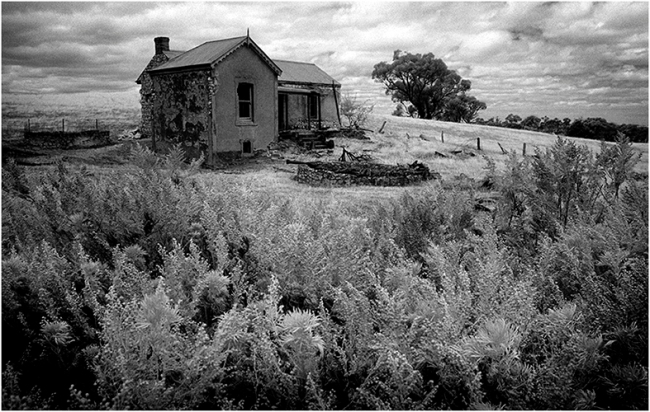I’m getting excited. The Ballarat International Foto Biennale, a celebration of all things photographic, begins on August 22nd.
With its core artist program, fringe exhibitions, workshops, folio reviews and much more, BIFB 2015 is promising to be the best yet.
Once again, as part of the Fringe, I will be exhibiting at Gallery On Sturt. The theme for my show, Time Lapsed, will be memory and time.
Late one night, feeling bored, I watched the movie The Rover starring Guy Pearce (which I enjoyed – I’ll watch almost anything set in the Australian bush). There is a scene where Pearce’s character enters an old building and I found myself thinking, “I know that place”. After some head scratching I realised the building in question was the old pub at Hammond, a ghost town on the Willochra Plain in the Mid North of South Australia.

Hammond Pub 1992
Seeing this I was filled with the urge to visit the Mid North, an area I feel a real connection to. This stems from having spent a lot time travelling and photographing in the region, mostly during the 90s. Many of the resulting photographs were included in my exhibition Postcards from forgotten places held at the Flinders University Art Museum in 2006/7.

Terowie 1996 (from Postcards from forgotten places)
My wish to revisit a few of these sites (some of which I hadn’t seen for twenty years) was soon granted when, not long after that late night in front of the TV, my friend Mike and I headed up the Main North Road for a quick road trip around the Mid North.

Murray Town 2015
We had a great time and it occurred to me that it would be good to rephotograph some of the subjects I’d shot previously. This led to me contemplating the themes of time and memory and realising that I had an exhibition in the making.
I found it interesting to see sites visited in the past, contemplating my recollections of them and how they appear to me now. The weather, the light, one’s state of mind and even who you are with at the time can influence memories of a place. Revisiting that place one might find those memories challenged. Differences in the above factors along with changes in the place itself, however subtle, and even changes that may have occurred in one’s self, can help create a new perspective and, in turn, new memories.

Booleroo Centre 1995
Twenty years is a reasonably long time. In that period there have been many changes in the world including the emergence of digital technology. I couldn’t have imagined on my first visits that I would one day return with a digital camera.

Booleroo Centre 2015
Of course, the digital revolution is of only minor significance compared with all the political upheavals, financial crises, acts of terrorism and natural disasters that have occurred in the last two decades.
However, in parts of the Mid North, where things have barely changed at all, it’s as though time has stood still. All the madness and chaos of the outside world have barely registered. This all makes for a nice place to retreat to for a while.

Black Rock 1995

Black Rock 2015































































